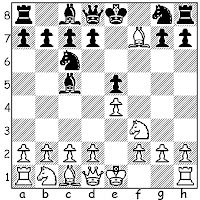The following game is a titanic struggle and monumental effort by both parties. White's early Queen moves prompt his opponent to try to punish them. Before a couple of dozen moves are past, an unbalanced (but balanced) endgame presents itself, and the game is not yet half over.
Bill Wall's endgame play is worth studying by any Jerome Gambiteer who suspects that he might not win all his games by first round knockout.
Wall,B (2000) - Seven11
Chess.com, 2008
1.e4 e5 2.Nf3 Nc6 3.Bc4 Bc5 4.Bxf7+
4...Kxf7 5.Nxe5+ Nxe5 6.Qh5+ Ng6
7.Qxc5 d6 8.Qd5+
A different way to "put the question to the Bishop." Does Black want to play 8...Be6 and allow 9.Qxb7, ?
In three previous games, Bill's opponents have answered no, no, and yes with 8...Ke7 (Wall - Guest 4395, Microsoft Internet Gaming Zone, 2001 [1-0, 18]), 8...Kf8 (Wall - Chung, Chess.com, 2010 [1-0, 25]) and 8...Be6 (Wall - CheckMe, Chess.com, 2010 [1-0, 23]). - Rick
8...Ke8
9.d3 c6 10.Qb3 Nf6 11.0-0 Qe7 12.Nc3 Be6 13.Qa4 b5 14.Qa6 Qc7 15.Be3 Ke7 16.f4 Bc8 17.Qa3 c5
Black's play against White's Queen has been quite aggressive (13...b5!?, 15...Ke7!?, 16...Bc8!?) and although White may "objectively" have a whisper of an advantage in the diagrammed position (at least if it is Houdini 3 doing the whispering) the game is tense and complicated.
18.Nxb5
The natural move that White wants to make, and that Black wants him to make.
The un-natural (read: computer) move is 18.e5!? when 18...b4 19.exf6+ Kf7 20.Qb3+ Be6 21.Nd5 Qb7 22.c4 Bxd5 23.cxd5 gxf6 would be a mess, but, perhaps, a White-tinged mess.
18...Qc6 19.Nxa7 Qb7 20.Nxc8+ Rhxc8
White now has four pawns for his sacrificed piece, but Black's pressure on the Queenside is substantial.
Black's goal is to recover some material. Whit'es goal is to move into an endgame where he has the prospects of converting a pawn.
21.Qc3 Qb4 22.f5 Qxc3 23.bxc3 Ne5
24.Bf4 Kd7 25.Bxe5 dxe5 26.a4 Ra5 27.Rfb1 Rc7 28.Rb5 Rca7
Houdini 3 says that 28...Rxb5 29.axb5 c4 30.Ra3 Kd6 31.Ra6+ Kc5 32.Re6 cxd3 33.cxd3 Kxb5 34.Rxe5+ Ka4 would also be equal,
 |
| analysis diagram |
but wouldn't you rather have White?
29.c4
Bill suggests 29.Rxa5 Rxa5 30.h3 as an alternative.
29...Kc6
Likewise, Bill points out that 29...Rxa4 30.Rxa4 Rxa4 31.Rb7+ Ke8 32.Rxg7 Ra1+ 33.Kf2 Rc1 34.Kf3 Rxc2 would get rid of the annoying a-pawn and keep Black's remaining Rook active.
30.Rxa5 Rxa5 31.Kf2 Nh5?!
Getting active on the Kingside, and thus keeping White's King there. Bill prefers that Black shift his King over that way.
32.g4 Nf6 33.g5 Nh5
Not 33...Ng4+? 34.Kf3 Nxh2+ 35.Kg3 and the greedy Knight is trapped; while if 33...Nd7 then 34.h4.
34.Ke3 Nf4
White still has all of his pawns.
35.f6?!
Perhaps a bit precipitate. Bill prefers 35.h4 h5 36.gxh6 gxh6 37.c3.
35...g6?
Better: 35...gxf6 36.gxf6 Kd6 and still a game in balance.
36.c3?!
Better, too, to move the King to prepare to advance his h-pawn, 36.Kf3 Ne6 37.Kg4.
36...Nh3
Or 36...Ng2+ 37.Kf3 Nf4 38.d4 cxd4 39.cxd4 Nh3 40.dxe5 Nxg5+ 41.Kf4
37.d4
There is not much more in 37.Rf1 Ra8 38.a5 Nxg5 39.a6.
37...exd4+ 38.cxd4 cxd4+ 39.Kxd4 Nxg5
White now has four (!) passed pawns, and the easier game to play, but, to be fair to his opponent, the game is still even.
40.h4 Ne6+
There is no more in 40...Nf3+ 41.Kc3 Nxh4 42.f7 Ra8 43.a5 g5 44.a6 Ng6 45.a7 g4 46.Kc4 g3 47.Ke3 g2 48.Kf2 Ne5.
 |
| analysis diagram |
41.Kc3 Nc5
Bill points out that shifting defenders doesn't accomplish much: 41...Re5 42.a5 Rxe4 43.a6 Nc7 44.Rf1.
42.f7
Nothing more is available from 42.e5 Nd7 43.f7 Rxe5.
42...Ra8 43.Rf1
Or 43.e5 Kd7 44.Rf1 Rf8.
43...Nxe4+??
Black gobbles a poison pawn (with check). Who can blame him? He needed the patience to find 43...Rf8 44.e5 Kd7 45.Kd4 Ne6+ 46.Kd5 Ke7 47.c5 Rd8+ 48.Kc4 Rc8 49.Kb4 Kf8, when White's energy exhausts itself, e.g. 50.a5 Nxc5 51.Kb5 Ne6 52.Rd1 Kxf7 53.Rd7+ Kg8 54.Rd6 Re8 55.Kb6 Nd8 56.a6 Nf7 57.Rd5 Nxe5 58.a7 Re6+ and Black's checks will keep White's last dangerous pawn from Queening. Whew!
44.Kd4 Rf8
Bill gives this move a "?", but after the alternative 44...Ng3 45.f8Q Rxf8 46.Rxf8 Nf5+ 47.Kc3 Nxh4 48.a5 White is more than just the exchange ahead. His a-pawn will cost Black his Knight, and his Rook can feast on the remaining two Black pawns long before they become threats to Queen.
45.Kxe4 Kc5
46.a5 Kxc4 47.a6 Kb5 48.a7 Kb6 49.Ra1 Ra8 50.Rb1+ Kc6 51.Rb8 Black resigned
















































